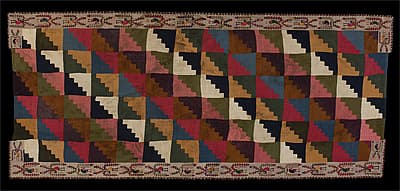
PARACAS culture South coast 700 BC – 200 AD
Mantle with stepped pattern c. 100-200 AD wool190.0 (h) x 252.0 (w) cm Ministerio de Cultura del Perú: Museo Nacional de Arqueología, Antropología e Historia del Perú, Photograph: Daniel Giannoni
The mantle is one of 45 alpaca wool mantles found wrapped around a mummy bundle. It retained its exquisite colours because of the dry desert conditions and protection from light. Ancient Peruvian weavers invented unusual and complex techniques such as the discontinuous warp and weft used here. The stepped design may refer to mountains, irrigation terraces or temples. Lima bean deities are embroidered around the borders. Four extensions emanate from each masked head and end in grimacing trophy heads.
The mantle is one of 45 alpaca wool mantles found wrapped around a mummy bundle. It retained its exquisite colours because of the dry desert conditions and protection from light. Ancient Peruvian weavers invented unusual and complex techniques such as the discontinuous warp and weft used here. The stepped design may refer to mountains, irrigation terraces or temples. Lima bean deities are embroidered around the borders. Four extensions emanate from each masked head and end in grimacing trophy heads.
The mantle is one of 45 alpaca wool mantles found wrapped around a mummy bundle. It retained its exquisite colours because of the dry desert conditions and protection from light. Ancient Peruvian weavers invented unusual and complex techniques such as the discontinuous warp and weft used here. The stepped design may refer to mountains, irrigation terraces or temples. Lima bean deities are embroidered around the borders. Four extensions emanate from each masked head and end in grimacing trophy heads.

